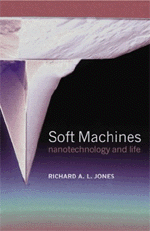What are the possible impacts of nanotechnology? The answer you get depends on which of nanotechnology’s warring camps you ask. On the negative side, the supporters of Drexler paint a chilling picture of economies dislocated, overwhelming military hegemony for the technology’s developers, and at worst global catastrophe. The nanotechnology mainstream in science and business doesn’t accept that Drexler’s vision is feasible; given this there’s a tendency in these circles to downplay the seriousness of nanotechnology’s potential negative consequences. In this, quite widespread, view, there may be some worries about the toxicity of nanoparticles to be investigated, but by and large we can expect business as usual. I think both views are wrong.
As I’ve made clear in many places, I doubt that Drexler’s vision of nanotechnology will come to pass. But when we come to discuss the impacts that nanotechnology might have, this matters less than one might think. I disagree with the analysis of Drexlerian groups like the Centre for Responsible Nanotechnology on many economic grounds as well as scientific ones, but there are a surprising number of places where I think that what they predict as impacts of Drexlerian nanotechnology will happen anyway. In fact, quite a few of these impacts are underway right now.
The debate about the social consequences of nanotechnology is becoming polarised in exactly the same way as the technical debate. This is unhealthy and unnecessary; many of the impacts of technology are independent of the precise form that the technology takes. If computing power, in 30 years, is much cheaper and much more ubiquitous than it is now, then the social consequences that follow from that don’t depend on whether those computers are powered by molecular electronics, quantum computing or Drexler’s rod logic.
Nanobusiness and nanoscientists need to raise themselves above their next grant proposal and funding round and start to think through the ways in which nanotechnology will be changing the world on a 20-30 years timescale. Prediction is very difficult, especially about the future (to quote Niels Bohr). But we do need to be thinking about bigger issues than how to regulate the disposal of nanotube enabled tennis rackets, important though it is to get those things right. The development of ubiquitous and ambient computing, the blurring of the line between human and machine; these are big issues that do deserve attention. And on the positive side, it’s going to be increasingly difficult to sell the huge outlays of taxpayers money by referring to the benefits of better cosmetics, important markets though those are. It’s not as though humanity isn’t facing some big challenges, and nanotechnology, if directed appropriately, could make some big positive impacts. Moving to a sustainable energy economy is one of our biggest challenges, and this is an area in which Richard Smalley has been rightly emphasising the transformational contributions incremental and evolutionary nanotechnologies can make .
Meanwhile, followers of Drexler are in danger of finding themselves in denial about the potential impact of ordinary, evolutionary nanotechnology, because of their devotion to their brand of nanotechnology’s one true path. As they continue to insist that the development of true nanotechnology is being thwarted for short-sighted political reasons, they may overlook the far-reaching changes that evolutionary nanotechnology will bring. It would be ironic if, in thirty years, the Drexlerites find themselves still waiting for a revolution that’s already happened.
